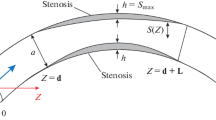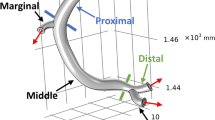Abstract
The main objective of this work was to use desktop workstations to evaluate the computer code HEMO as a tool for predicting coronary blood flows. The flows are usually characterised by complex vortical structures and transitional effects, and as such present challenging computational problems. As the results of the computations shown in the paper demonstrate, we can predict realistic pulsatile flows in constricted tubes using the Sun Sparcstation 1+ in a matter of hours. The results shown in the paper have also demonstrated that the computer simulations can be very useful as a complementary tool for experimental investigations.
Similar content being viewed by others
References
Ahmed, S., andGiddens, D. P. (1984): ‘Pulsatile poststenotic flow studies with laser Doppler anemometry’,J. Biomech.,17, p. 695
Bassenge, E., andBusse, R. (1988) ‘Endothelial modulation of vascular tone’,Progr. Cardiovasc. Dis.,30, pp. 349–380
Caro, E. G., Fitzgerald, J. M., andSchroter, R. C. (1971): ‘Atheroma and arterial wall shear. Observation correlation and proposal for a shear-dependent mass transfer mechanism for atherogenesis,’Proc. R. Soc. London,B 117, pp. 109–159
Chorin, A. J. (1968): ‘Numerical solution of the Navier-Stokes equations’,Math. Comput.,22, p. 742.
Chorin, A. J. (1989): ‘Computational fluid mechanics’ (Academic Press)
Dukowicz, J. K., andDvinsky, A. S. (1992): ‘Approximate factorization as a high order splitting for the implicit incompressible flow equations,’J. Comput. Phys.,102, pp. 336–347
Dvinsky, A. S. (1987): ‘FLUENT/BFC: a general purpose flow modeling program for all flow speeds’ inTaylor, C. et al. (Eds.) ‘Numerical methods in laminar and turbulent flow’ (Pineridge Press)
Dvinsky, A. S. (1991): ‘Adaptive grid generation from harmonic maps on Riemannian manifolds’,J. Comput. Phys.,95, p. 450
Dvinsky, A. S., Ojha, M., andPerng, C.-Y. (1991): ‘A transitional pulsatile flow through an asymmetrically constricted tube: a numerical investigation’in Vanderby, R. (Ed.), ‘Advances in bioengineering’ (ASME) Vol. 20
Dvinsky, A. S., andDukowicz, J. K. (1993): ‘Null-space-free methods for the incompressible Navier-Stokes equations on non-staggered curvilinear grids’,Computers & Fluids,22, (6), pp. 685–696
Glagov, S., Zarins, C., Giddens, D. P., andKu, D. (1988): ‘Hemodynamics and atherosclerosis’,Arch. pathol. Lab. Med.,112, p. 1019.
Hamakiotes, C. S., andBerger, S. A. (1988): ‘Fully developed pulsatile flow in a curved pipe’,J. Fluid Mech.,195, p. 23
Harlow, F. H., andWelch, J. E. (1965): ‘Numerical calculation of time-dependent viscous incompressible flow of fluid with free surface’,Phys. Fluids,8, p. 2182
Ku, D. N., Zeigler, M. N., andDowning, J. M. (1990): ‘One-dimensional steady inviscid flow through a stenotic collapsible tube’,J. Biomech. Eng.,112, pp. 444–450
Langille, B. L., andO’Donnell, F. (1986): ‘Reductions in arterial diameter produced by chronic decreases in blood flow are endothelium dependent’,Science,231, pp. 405–407
Lieber, B. B., andGiddens, D. P. (1990): ‘Post-stenotic core flow behavior in pulsatile flow and its effects on wall shear stress’,J. Biomech.,6, p. 597
Ojha, M., Cobbold, R. S. C., Johnston, K. W., andHummel, R. L. (1989): ‘Pulsatile flow through constricted tubes: an experimental investigation using photochromic tracer methods’,J. Fluid Mech.,203, p. 173
Ojha, M., Cobbold, R. S. C., Johnston, K. W., andHummel, R. L. (1990): ‘Detailed visualization of pulsatile flow fields produced by modelled arterial stenoses’,J. Biomed. Eng.,12, pp. 463–469
Patel, D. J., andVaishnav, R. N. (1980): ‘Basic hemodynamics and its role in disease process’ (University Park Press, Baltimore, Maryland)
Peskin, C. S. (1977): ‘Numerical analysis of blood flow in the heart’,J. Comp. Phys.,25, p. 220
Rittgers, S. E., andShu, M. C. S. (1990): ‘Doppler color-flow images from a stenosed arterial model. Interpretation of flow patterns’,J. Vasc. Surg.,12, p. 511
Young, D. F., andTsai, F. Y. (1973): ‘Flow characteristics in models of arterial stenoses’,J. Biomech.,6, pp. 395; 547
Author information
Authors and Affiliations
Rights and permissions
About this article
Cite this article
Dvinsky, A.S., Ojha, M. Simulation of three-dimensional pulsatile flow through an asymmetric stenosis. Med. Biol. Eng. Comput. 32, 138–142 (1994). https://doi.org/10.1007/BF02518910
Received:
Accepted:
Issue Date:
DOI: https://doi.org/10.1007/BF02518910




